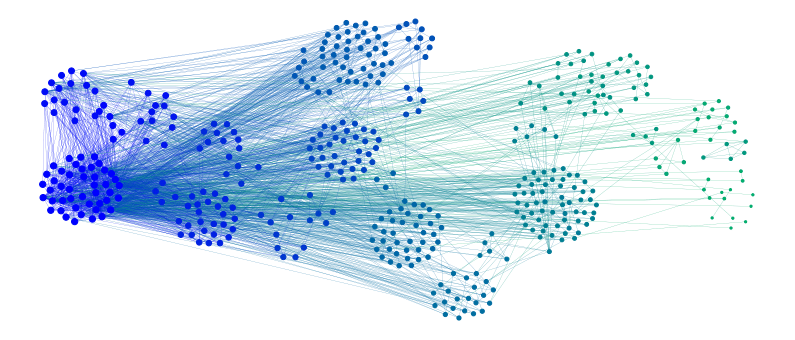Graph Analysis via
\(p\)-Modulus
Nathan Albin
K-State Mathematics


Theory and Applications
Shameless Plug

Modulus in the Continuum
All paths connecting A to B
All paths connecting A to B
Modulus on a Graph

admissible but not optimal
Effective Resistance
\(1\)
\(1\)
\(1\)
\(1\)
\(1\)
\(1\)
\(2\)
\(1\)
\(\frac{2}{3}\)
\(\frac{5}{3}\)
Effective Resistance
\(1\)
\(1\)
\(1\)
\(1\)
\(1\)
\(1\)
\(2\)
\(1\)
\(\frac{2}{3}\)
\(\frac{5}{3}\)
The Probabilistic Interpretation
\(\underline{\gamma},\underline{\gamma'}\) are iid random paths
\(\mathbb{P}\left(\underline{\gamma}=\gamma_i\right) = \mu(\gamma_i)\)
Minimum Expected Overlap
\(\underline{\gamma},\underline{\gamma'}\) are iid random paths
\(\mathbb{P}\left(\underline{\gamma}=\gamma_i\right) = \mu(\gamma_i)\)
Minimum Expected Overlap
\(\underline{\gamma},\underline{\gamma'}\) are iid random paths
\(\mathbb{P}\left(\underline{\gamma}=\gamma_i\right) = \mu(\gamma_i)\)
Minimum Expected Overlap
Minimum Expected Overlap
pmfs on \(\Gamma\)
modulus prefers short paths + variety
Canonical Example
\(k\) parallel paths of length \(\ell\)
\(\mu(\gamma_i)=\frac{1}{k}\) for \(i=1,2,\ldots,k\)
Generalizing the Energy
Shortest Path
Max-Flow Min-Cut
Effective Resistance
Modulus Metrics
is a metric for \(1<p<\infty\)
Generalizing the Family of Objects
Objects are Vectors
Objects are Vectors
In general, \(\Gamma\subset\mathbb{R}^E_{\ge 0}\)
\(\text{Mod}(\Gamma)\)
\(\text{Mod}(\Gamma)\)
Fulkerson Duality
Fulkerson Duality
Fulkerson Duality
Fulkerson Duality
Fulkerson Duality
Key Example:
\(\Gamma\) = \(ab\)-paths
\(\hat{\Gamma}\) = \(ab\)-cuts
\(1-\alpha\)
\(1-\alpha\)
\(1\)
\(\alpha\)
\(\frac{1}{3}\)
\(\frac{1}{3}\)
\(1\)
\(\frac{2}{3}\)
\(\frac{3}{5}\)
\(\frac{2}{5}\)
\(\frac{1}{5}\)
\(\frac{1}{5}\)
\(\frac{1}{3}\)
\(\frac{1}{3}\)
\(1\)
\(\frac{2}{3}\)
\(\mu(\gamma_2)=\frac{2}{3}\)
\(\mu(\gamma_1)=\frac{1}{3}\)
Families and Structural Properties
| family | property |
|---|---|
| connecting paths | metrics |
| spanning trees | hierarchical structure |
| cycles | communities |
| center-to-shell paths | centrality |
| via walks | betweenness |

Modulus Doesn't Need Graphs
What do we need?
- "ground set" \(E\)
- "objects" \(\Gamma\in\mathbb{R}^E_{\ge 0}\)
For example,
- hypergraphs
- matroids
- permutations
- ...
Play With the Code
Thank You

these slides
Introduction to Discrete Modulus
By nathan_albin
Introduction to Discrete Modulus
- 78



